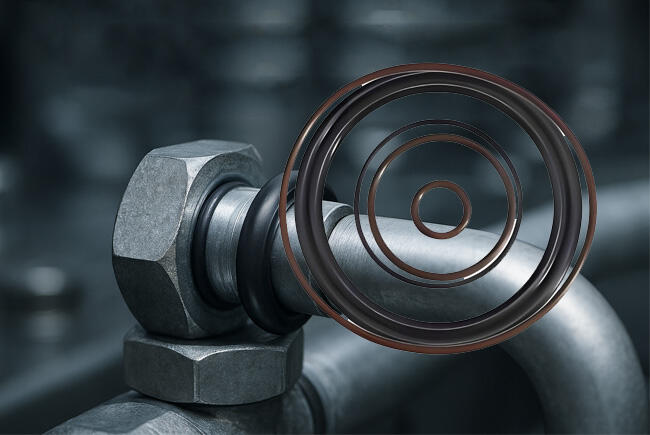When pressure spikes, temperature cycles, and vibration stack up, reliability comes from disciplined basics rather than exotic hardware. The o ring series thrives in exactly these circumstances. With a circular cross‑section, mature gland standards, and a vast materials palette, O‑rings deliver predictable sealing across mechanical engineering, hydraulic and pneumatic systems, and oil and gas—particularly where high‑pressure sealing is required in bolted bosses, threaded ports, and pipe joints.
Why the o ring series still leads the shortlist
· High‑pressure interfaces: Axial and radial face seals on bolt heads and straight‑thread bosses; compact, “tighten‑to‑seal” behavior with proven repeatability.
· Static and dynamic: Axial/radial/dovetail/boss for static service; reciprocating/rotary/oscillating for motion—with back‑up rings to manage extrusion where clearance gaps exist.
· Where it fits best: Pumps, motors, gearboxes, engines and lube circuits; hydraulic/pneumatic manifolds and actuators; construction and agricultural machinery; oil and gas production/transfer; chemical plants and metallurgical lines; water treatment skids; wind turbine yaw/pitch hydraulics; marine/offshore packages; household appliances with critical seals; rail rolling stock subsystems; commercial vehicles and heavy‑duty trucks; industrial machinery, robotic arms, and actuators using hydraulic or pneumatic drives.

How O‑rings seal—and the limits to respect
· Mechanism: Installed in a gland and compressed axially or radially, the elastomer deforms to close leakage paths; media pressure energizes the contact, yielding a positive seal.
· Pressure envelope: Proper glands and preload support mid‑to‑high static pressures common to hydraulic duty; ultimate limits depend on section size, compound hardness, clearance gap, surface finish, and clamp load. Hard compounds and back‑up rings curb extrusion at elevated pressure.
· Temperature and life: Balance low‑temperature flexibility with high‑temperature compression set; life is shaped by duty cycle, thermal swings, and vibration.
· Failure modes and mitigation: Extrusion, twist, installation nicks, chemical incompatibility, and explosive decompression are addressed via geometry control, material choice, back‑ups, compatible lubricants, and qualification testing.
Materials and families within the series
Elastomers commonly used:
· NBR: General oil service;
· EPDM: Water and selected chemicals;
· VMQ: Wide temperature window and low‑temp elasticity;
· FKM: Elevated temperature and aggressive media;
· PTFE and encapsulated variants: Low friction and chemical resistance.
Hardness and compounding: Shore A ≈ 35–90. Softer compounds seal at lower loads but extrude sooner; harder compounds resist extrusion yet demand tighter gland control. Fillers, crosslink systems, and additives tune compression set, ageing, and media compatibility.
Size systems: Metric, imperial, AS568, ISO 3601 and others provide wide interchangeability with threaded bosses, pipe joints, and flange auxiliaries; custom cross‑sections and compounds serve legacy and niche duties.
Selection and assembly: a focused checklist
Start with four variables:
· Medium: Oils, chemicals, cleaners, and steam drive compatibility;
· Pressure: Peaks and ramp rate define hardness and whether back‑ups are needed;
· Temperature: Low‑temperature start‑up versus high‑temperature dwell;
· Time: Duty cycle and life target guide compound and margin.
Glands and squeeze:
· Static: About 15–25% squeeze (higher for vacuum);
· Dynamic: About 8–16%, with small sections sometimes up to ~20% in constrained cases;
Geometry: Groove width greater than depth; always include the clearance gap in calculations.
Assembly and lubrication: Chamfer and deburr; avoid twist and over‑stretch; use media‑compatible lubricants; ramp pressure on commissioning and complete a leak check.
Storage and upkeep: Protect from heat, UV/ozone, and strain; rotate stock FIFO; set inspection/replacement intervals to the compound and duty.
Work with NQKSF: from spec to field‑ready
Service capabilities:
· Fast shipment of standard parts: A wide inventory covering O‑rings, oil seals, and related references for urgent demands;
· End‑to‑end customization: Material selection, groove design, production, and testing for non‑standard seals tailored to your media, pressure, and temperature;
· Technical enablement: Over 30 years in sealing, helping optimize performance, reduce maintenance cost, and improve equipment reliability.
Company highlights:
· In‑house intelligent manufacturing;
· A seasoned sealing brand;
· Broad model coverage with ready stock;
· Shipments to 80+ countries;
· Collaboration with well‑known global brands;
· Provincial technology innovation center;
· Recognized as a specialized and innovative enterprise;
· High‑tech enterprise;
· A leading representative within a featured industrial cluster.
The o ring series is unglamorous by design—and that’s its strength. It turns volatile interfaces into repeatable assemblies through correct material, gland, and preload. If you’re balancing high pressure, wide temperature, and tricky media, NQKSF can align compounds and geometry, then verify them in production tests—so every joint you tighten behaves the way you planned.
 Hot News
Hot News